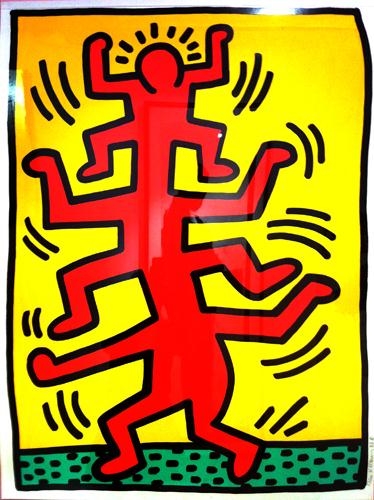East Village Alchemy
In the late 1970鈥檚, an explosion of creative passion gave birth to the legendary East Village arts movement. These artists used their gifts to address social and political issues directly with the viewer in street settings, frequently facing incarceration for this practice. In this exhibition, we explore four of the scene鈥檚 seminal creators and practitioners of street based art.
In 1980, Keith Haring began creating his famously ephemeral chalk drawings on unused subway platform advertising spaces. He continued this practice to great public acclaim, eventually completing hundreds of these drawings. In this exhibition, we are proud to present a rare collection of Haring鈥檚 subway chalk masterpieces. Keith Haring鈥檚 works are included in the collections of Museum of Modern Art, The Whitney Museum, The Andy Warhol Museum, L. A. County Museum of Art, Museum of Contemporary Art, L. A. and numerous additional national and international museum collections.
Paolo Buggiani was part of the Italian Painting Avant garde in the early fifties while he was living in Rome. He moved to New York in 1962 and in 1968 received the Guggenheim Fellowship for Sculpture in America with his experiments using a new method of sculpture called the Vacuum Forming System.During this period he was also researching the concept of time as it relates to Art. Returning to Italy in May 1968, he was active both in Rome and Milan. Buggiani's research at the time included "Ephemeral Sculpture in Motion", "Fire" (as Performing Art and Installation), "Paintings over Reality" and "Wearable Art". He returned to New York in 1978 and started working on a new series called Urban Mythology while producing his Mechanical Reptiles creatures. These sculptures placed into the urban environment brought him popularity as one of the most important members of the Street Art Movement. Today Buggiani is regarded as one of the most independent contemporary artists and is internationally recognized for his installations of fire sculptures.
In 1982, the Japanese-American artist Ken Hiratsuka arrived in the East Village to begin his practice of hand chiseling continuous lines into the sidewalks and streets of the neighborhood. Ken鈥檚 universal line philosophy informs his work to the present day. Ken Hiratsuka鈥檚 works are included in the collections of Hara Museum of Contemporary Art; Japan, Modern Art Museum; Brazil, Kemi Art Museum; Finland, Tornio Museum; Finland and numerous additional national and international museum collections.
In 1983, Scot Borofsky began forming his language of urban symbols, painting his work on walls across the East Village. Scot鈥檚 language has continued to evolve, informing a new generation of viewers. Scot Borofsky鈥檚 works are included in the collections of The Metroplitan Museum, Brooklyn Museum of Art, Pierpont Morgan Library, Werner Kramarski and numerous additional national and international museum collections.

Recommended for you
In the late 1970鈥檚, an explosion of creative passion gave birth to the legendary East Village arts movement. These artists used their gifts to address social and political issues directly with the viewer in street settings, frequently facing incarceration for this practice. In this exhibition, we explore four of the scene鈥檚 seminal creators and practitioners of street based art.
In 1980, Keith Haring began creating his famously ephemeral chalk drawings on unused subway platform advertising spaces. He continued this practice to great public acclaim, eventually completing hundreds of these drawings. In this exhibition, we are proud to present a rare collection of Haring鈥檚 subway chalk masterpieces. Keith Haring鈥檚 works are included in the collections of Museum of Modern Art, The Whitney Museum, The Andy Warhol Museum, L. A. County Museum of Art, Museum of Contemporary Art, L. A. and numerous additional national and international museum collections.
Paolo Buggiani was part of the Italian Painting Avant garde in the early fifties while he was living in Rome. He moved to New York in 1962 and in 1968 received the Guggenheim Fellowship for Sculpture in America with his experiments using a new method of sculpture called the Vacuum Forming System.During this period he was also researching the concept of time as it relates to Art. Returning to Italy in May 1968, he was active both in Rome and Milan. Buggiani's research at the time included "Ephemeral Sculpture in Motion", "Fire" (as Performing Art and Installation), "Paintings over Reality" and "Wearable Art". He returned to New York in 1978 and started working on a new series called Urban Mythology while producing his Mechanical Reptiles creatures. These sculptures placed into the urban environment brought him popularity as one of the most important members of the Street Art Movement. Today Buggiani is regarded as one of the most independent contemporary artists and is internationally recognized for his installations of fire sculptures.
In 1982, the Japanese-American artist Ken Hiratsuka arrived in the East Village to begin his practice of hand chiseling continuous lines into the sidewalks and streets of the neighborhood. Ken鈥檚 universal line philosophy informs his work to the present day. Ken Hiratsuka鈥檚 works are included in the collections of Hara Museum of Contemporary Art; Japan, Modern Art Museum; Brazil, Kemi Art Museum; Finland, Tornio Museum; Finland and numerous additional national and international museum collections.
In 1983, Scot Borofsky began forming his language of urban symbols, painting his work on walls across the East Village. Scot鈥檚 language has continued to evolve, informing a new generation of viewers. Scot Borofsky鈥檚 works are included in the collections of The Metroplitan Museum, Brooklyn Museum of Art, Pierpont Morgan Library, Werner Kramarski and numerous additional national and international museum collections.

 ARTISTS
ARTISTS












